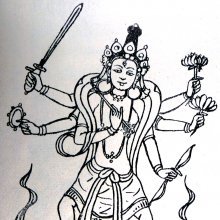Piercing: 2 definitions
Introduction:
Piercing means something in Hinduism, Sanskrit. If you want to know the exact meaning, history, etymology or English translation of this term then check out the descriptions on this page. Add your comment or reference to a book if you want to contribute to this summary article.
Images (photo gallery)
In Hinduism
Natyashastra (theatrics and dramaturgy)
Source: Shodhganga: Elements of Art and Architecture in the Trtiyakhanda of the Visnudharmottarapurana (natya)Piercing (with powerful weapon) is associated with Mṛgaśīrṣa-hasta: one of the twenty-two Single-hand Gestures (in Indian Dramas) (known as asaṃyuktahastas), according to the Viṣṇudharmottarapurāṇa, an ancient Sanskrit text which (being encyclopedic in nature) deals with a variety of cultural topics such as arts, architecture, music, grammar and astronomy.—The word mṛgaśīrṣa is the union of two words viz., mṛga and śīrṣa. The word mṛga means deer and śīrṣa means head. So, it can be said that the hand posture which is called mṛgaśīrṣa identifies a posture that looks like the head of a deer. [...] The mṛgaśīrṣa-hasta posture is used to denote piercing, cutting, and moving upward of the powerful weapon.

Natyashastra (नाट्यशास्त्र, nāṭyaśāstra) refers to both the ancient Indian tradition (shastra) of performing arts, (natya—theatrics, drama, dance, music), as well as the name of a Sanskrit work dealing with these subjects. It also teaches the rules for composing Dramatic plays (nataka), construction and performance of Theater, and Poetic works (kavya).
Yoga (school of philosophy)
Source: ORA: Amanaska (king of all yogas): A Critical Edition and Annotated Translation by Jason BirchPiercing (the Cakras) can denoted by the Sanskrit terms Bheda and Vedha, according to the Amanaska Yoga treatise dealing with meditation, absorption, yogic powers and liberation.—Accordingly, as Īśvara says to Vāmadeva: “[...] There is no transition to the no-mind state because of piercing (bheda) [Cakras, knots, etc.] with lower and upper Kuṇḍalinī. Simply by [constant] immersion [of the mind in the internal gaze of Śāmbhavī Mudrā], this yoga bestows the supernatural powers. [...]”.

Yoga is originally considered a branch of Hindu philosophy (astika), but both ancient and modern Yoga combine the physical, mental and spiritual. Yoga teaches various physical techniques also known as āsanas (postures), used for various purposes (eg., meditation, contemplation, relaxation).
See also (Relevant definitions)
Starts with: Piercing grass.
Full-text (+501): Vedhana, Vedha, Vedhin, Hridayavidh, Apavedha, Vyadhana, Karnavedha, Vranana, Vidra, Bhedana, Vijjhana, Vedhaka, Shishnatha, Shnathana, Cittavedhaka, Prabhedaka, Lakshyabheda, Vyadhi, Nitoda, Hridayacchid.
Relevant text
Search found 151 books and stories containing Piercing; (plurals include: Piercings). You can also click to the full overview containing English textual excerpts. Below are direct links for the most relevant articles:
Manusmriti with the Commentary of Medhatithi (by Ganganatha Jha)
Verse 8.325 < [Section XLIII - Theft (steya)]
Verse 4.215 < [Section XIV - Other Duties]
Verse 8.284 < [Section XLII - Assaults]
Brahma Sutras (Nimbarka commentary) (by Roma Bose)
Brahma-Sūtra 3.3.25 < [Adhikaraṇa 10 - Sūtra 25]
Adhikaraṇa 10 - Sūtra 25 < [Pāda 3 - Third quarter]
The Garuda Purana (by Manmatha Nath Dutt)
Chapter CLXXXIX - The Nidanam of traumatic ulcers etc < [Dhanvantari Samhita]
Chapter CLXXII - The Nidanam of diseases of the head < [Dhanvantari Samhita]
Chapter CXLIX - The Nidanam of Cough < [Dhanvantari Samhita]
Brahma Sutras (Shankara Bhashya) (by Swami Vireshwarananda)
Chapter III, Section III, Adhikarana XIV < [Section III]
Mahabharata (English) (by Kisari Mohan Ganguli)
Section CXXXIII < [Jayadratha-Vadha Parva]
Section CLXXIV < [Caitraratha Parva]
Section XLI < [Abhimanyu-badha Parva]
Brahma Sutras (Ramanuja) (by George Thibaut)
Sutra 3.3.25 < [Third Adhyaya, Third Pada]
Related products

